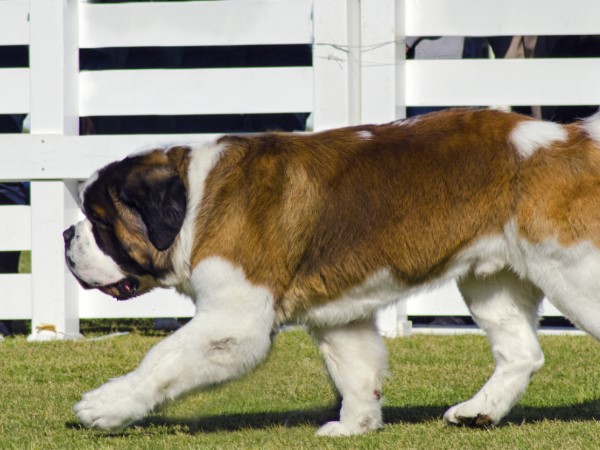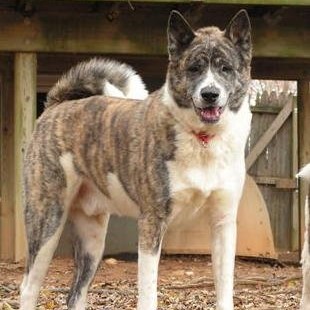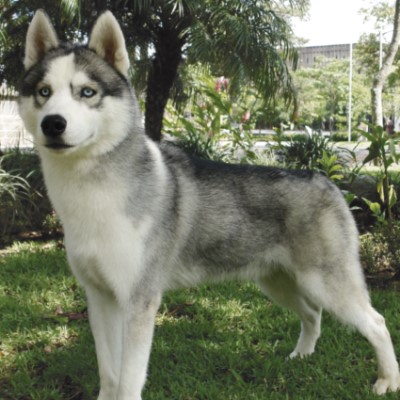Common Reasons for Surrender
The number one reason this breed is surrendered is the dog got too big. The second biggest reason a Saint Bernard is surrendered is the family moves and the new home does not accommodate the dog. A third reason the Saint Bernard is surrendered is the people didn’t understand how to train or discipline the dog, and they were frustrated because he jumped on people or charged the fence when people came to visit.
Pros
The Saint Bernard does not forget a kindness, especially those who were rescued from a bad situation. She shows a lot of devotion to her people. She’s good with strangers and children and even gets along with other dogs. Most of the time, she will be patient if a child  steps on her foot or hugs her too tightly. Saints are known to be affectionate and give slobbery kisses to their family and, unless trained not to, they will seek out a person to snuggle with at bedtime.
steps on her foot or hugs her too tightly. Saints are known to be affectionate and give slobbery kisses to their family and, unless trained not to, they will seek out a person to snuggle with at bedtime.
Cons
The two biggest cons are excessive shedding and excessive drooling. Some owners keep a towel or a cloth nearby at all times to wipe the dog’s mouth. Eight to 10 years is a relatively short life expectancy, which can be difficult for the family. Saints have been known to not only chew a shoe but to eat the entire shoe. Saints are big dogs, known to be stubborn, and can take up the entire couch. (This problem can be alleviated if you train your dog not to get on your furniture). They step on your feet and, unless you train them in proper leash manners, they’ll drag you to the destination of their choice. Again, this issue can be managed with dog obedience training. If you are ready to take on the responsibility of a dog that drools, sheds, and eats a lot, the Saint Bernard will reward you with a loyal and loving friendship.
Diet
A lamb and rice kibble such as Purina One Lamb and Rice works well for Saint Bernards. The formula is bland, easy on their digestive system, helps their skin and coat, and even prevents ear infections.
Saint Bernards usually eat more food in the winter than in the summer. In the winter, you may provide seven to 10 cups of kibble per day and in the summer only two to four cups. One dog will eat 11 pounds of dog food in 10 days.
A hard milk bone, raw bone, or dental treats work well with breakfast and are good for hygiene. Beef flavored dental sticks (found in bulk at Sam’s Club) help plaque from building up on their teeth.
Exercise
The Saint Bernard needs moderate exercise such as walking once a day. Saint Bernards do not enjoy rigorous exercise such as jogging and strenuous hiking. In fact, the Saint Bernard enjoys his sleep more than exercise.
Possible Health Issues
The Saint Bernard is prone to hip dysplasia, heart problems, kidney problems, and cancer. Like all dogs, the Saint Bernard should be taken to the vet for well visits once a year and should be seen if the dog appears to be having health issues.
Housing
Saint Bernards in the 21st century are inside dogs. Even a farm should have a fenced-in yard for the Saint. As long as the adopting family will take the dog outside to relieve herself and to exercise, she can live in small quarters, including a downtown apartment.
Grooming
Twice a year the Saint will “blow her coat,” which means shed. The Saint Bernard has an undercoat and an outer coat and will shed in the winter to get her summer coat and shed again at the end of summer to get her winter coat. Their ears are large and floppy, but it’s important to clean them and keep them dry to prevent ear infections.
Daily brushing is recommended during shedding. Their nails are large and must be kept trimmed. Professional grooming can cost $40 to $80.
Training
The Saint Bernard will respond well to a calm but assertive command. Explore various collars and get advice from your dog obedience trainer on which collar is best for your dog. Harnesses are not recommended for walking but work beautifully for pulling wagons and carts around the yard.
Entertainment
Saint Bernards love to sleep. Depending on their personality, a Saint may like to carry around a toy or even bring you things.
ADDITIONAL RESOURCES
We want to thank the Illinois Saint Bernard Rescue for help with this profile.













